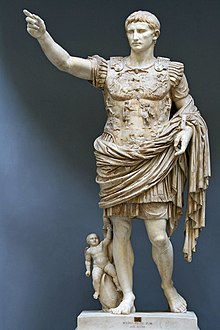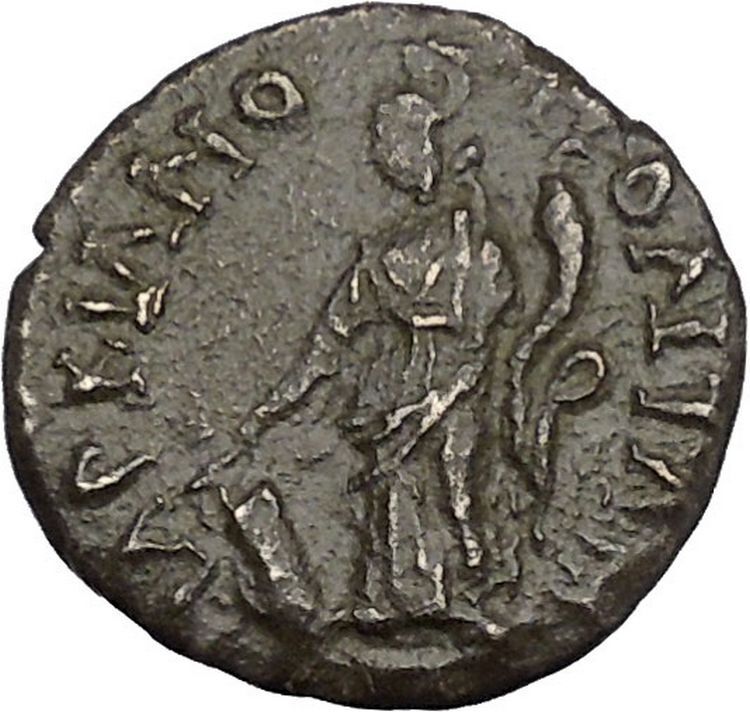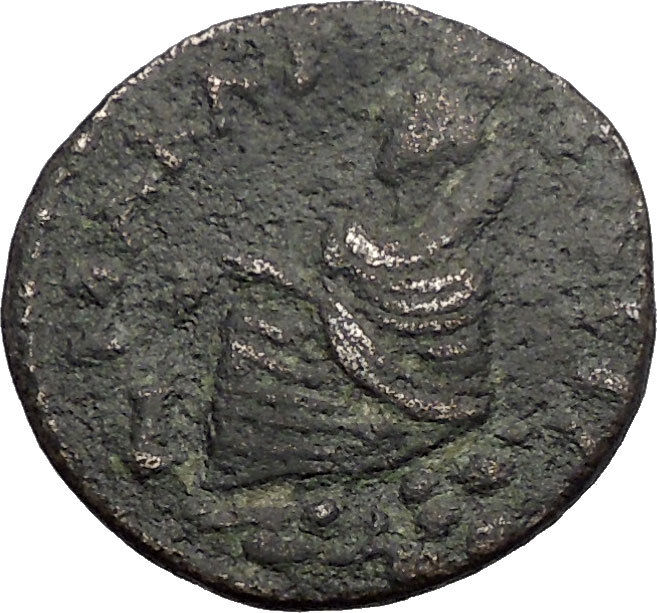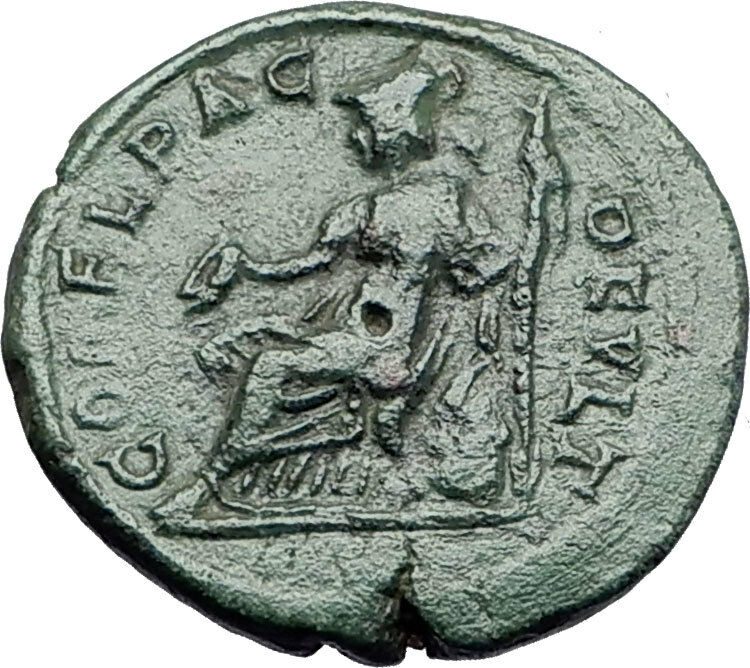|
Biblical Jerusalem and Judaea under Roman Administration
Marcus Ambibulus – Prefect: 9-12 A.D.
Struck under Augustus – Roman Emperor: 27 B.C. – 14 A.D.
Bronze Prutah 18mm (1.96 grams) Jerusalem mint, struck 8/9 A.D.
Reference: Hendin 1329 (5th Edition)
KAICAPOC (of Caesar), ear of grain curved to right
LΛΘ (year 39 = 8/9 A.D.) in fields; eight-branched palm tree bearing two bunches of dates.
Marcus Ambibulus was Roman Prefect of the province of Judaea and Samaria. Originally a cavalry officer, he succeeded Coponius in 9 AD and ruled the area until 13 AD when he was succeeded by Annius Rufus. Josephus noted his tenure in Antiquities 18.31.
You are bidding on the exact item pictured, provided with a Certificate of Authenticity and Lifetime Guarantee of Authenticity.
Starting with the Jewish Kings, most coins were minted at the Jerusalem mint. The Hosmoneon Dynasty coinage begins with John Hyrcanus I (135-104 B.C.) followed by Judah Aristobulus (104 B.C.), then Alexander Jannaeus (104-76 B.C.). The Herodian Dynasty came next with Herod I (the Great) (40-4 B.C.), followed by Herod Archelaus (4 B.C. – 6 A.D.), Herod Antipas (4 B.C. – 39 A.D.), Herod Philip and Herod Agrippa I (41-44 A.D.).
Roman Procurator coinage was issued under procurators and prefects of the province of Judaea which minted coins with names of contemporary emperors between circa 6 – 66 A.D. They minted only one denomination and size, the bronze Prutah. Not all of the procurators and prefects issued coinage in the province of Judaea under the Romans. Those that did issue coins were Coponius (6-9 A.D.) (under the Roman emperor Augustus, 27 B.C.-14A.D.), Marcus Ambibulus (9-12 A.D.), Valerius Gratus (15-18/26 A.D.) (time of Roman emperor Tiberius 14-37 A.D.), Pontius Pilate (26-36 A.D.), Antonius Felix (52-60 A.D.) (under Roman emperor Claudius 41-54 A.D.), and Porcius Festus (59-62 A.D.) (under emperor Nero 54-68 A.D.). The last three procurators were Lucceius Albinus, Gessius Florus and Marcus Antonius Julianus. They did not issue any coins since the First Jewish-Roman War was brewing during emperor Nero’s reign and the leaders of the revolt started issuing their own coins for the period known as the Jewish War (67-70 A.D.).
After the conquest of Jerusalem under Vespasian and Titus, this period of coinage ended and Romans commemorated the victories over Jerusalem and the surrounding area with Judaea Capta coinage.
Prutah (Hebrew: פרוטה) is a word borrowed from the Mishnah and the Talmud, in which it means “a coin of smaller value”. The word was probably derived originally from an Aramaic word with the same meaning.
The prutah was an ancient copper Jewish coin with low value. A loaf of bread in ancient times was worth about 10 prutot (plural of prutah). One prutah was also worth two lepta (singular lepton), which was the smallest denomination minted by the Hasmonean and Herodian Dynasty kings.
Prutot were also minted by the Roman Procurators of the Province of Judea, and later were minted by the Jews during the First Jewish Revolt (sometimes called ‘Masada coins’).
Judea (Hebrew: יהודה, Standard Yehuda Tiberian Yehûḏāh; Arabic: يهودا; Greek: Ἰουδαία; Latin: IVDAEA), sometimes spelled in its original Latin forms of Judæa, Judaea or Iudaea to distinguish it from the geographical region of Judea, was a Roman province that incorporated the geographical regions of Judea, Samaria, and Idumea, and which extended over parts of the former regions of the Hasmonean and Herodian kingdoms of Israel. It was named after Herod Archelaus’s Tetrarchy of Judea, of which it was an expansion, the latter name deriving from the Kingdom of Judah of the 6th century BCE.
Rome’s involvement in the area dated from 63 BCE, following the end of the Third Mithridatic War, when Rome made Syria a province. In that year, after the defeat of Mithridates VI of Pontus, the proconsul Pompeius Magnus (Pompey the Great) sacked Jerusalem and entered the Jerusalem Temple. Subsequently, during the 1st century BCE, the Herodian Kingdom was established as a Roman client kingdom and then in 6 CE parts became a province of the Roman Empire.
Judea province was the scene of unrest at its founding during the Census of Quirinius and several wars were fought in its history, known as the Jewish-Roman wars. The Temple was destroyed in 70 as part of the Great Jewish Revolt resulting in the institution of the Fiscus Judaicus, and after Bar Kokhba’s revolt (132-135 CE), the Roman Emperor Hadrian changed the name of the province to Syria Palaestina and Jerusalem to Aelia Capitolina, which certain scholars conclude was done in an attempt to remove the relationship of the Jewish people to the region.
Relations with Hasmonean and Herodian dynasties
The first intervention of Rome in the region dates from 63 BCE, following the end of the Third Mithridatic War, when Rome made a province of Syria. After the defeat of Mithridates VI of Pontus, Pompey (Pompey the Great) remained there to secure the area.
The region at the time was not a peaceful place. The Queen of Judaea Salome Alexandra had recently died and her sons, Hyrcanus II and Aristobulus II, divided against each other in a civil war.
In 63 BCE, Aristobulus was besieged in Jerusalem by his brother’s armies. He sent an envoy to Marcus Aemilius Scaurus, Pompey’s representative in the area. Aristobulus offered a massive bribe to be rescued, which Pompey promptly accepted. Afterwards, Aristobulus accused Scaurus of extortion. Since Scaurus was Pompey’s brother in law and protégée, the general retaliated by putting Hyrcanus in charge of the kingdom as Ethnarch and High Priest, but he was denied the title of King.
When Pompey was defeated by Julius Caesar, Hyrcanus was succeeded by his courtier Antipater the Idumaean, also known as Antipas, as the first Roman Procurator. In 57-55 BCE, Aulus Gabinius, proconsul of Syria, split the former Hasmonean Kingdom of Israel into five districts of the Sanhedrin.
Both Caesar and Antipater were killed in 44 BCE, and the Idumean Herod the Great, Antipater’s son, was designated “King of the Jews” by the Roman Senate in 40 BCE. He didn’t gain military control until 37 BCE. During his reign the last representatives of the Maccabees were eliminated, and the great port of Caesarea Maritima was built. He died in 4 BCE, and his kingdom was divided among three of his sons, who became tetrarchs (“rulers of a quarter part”, or in this case rather of “thirds”). One of these tetrarchies was Judea corresponding to the territory of the tribe of Judah, plus Samaria and Idumea. Herod’s son Herod Archelaus, ruled Judea so badly that he was dismissed in 6 CE by the Roman emperor Augustus, after an appeal from his own population. Another, Herod Antipas, ruled as tetrarch of Galilee and Perea from 4 BCE to 39 CE, being then dismissed by Caligula. The third tetrarch, Herod’s son Philip, ruled over the northwestern part of his father’s kingdom.
Judea as Roman province
In 6 CE Judea became part of a larger Roman province, called Iudaea, which was formed by combining Judea proper (biblical Judah) with Samaria and Idumea (biblical Edom). Even though Iudaea is simply derived from the Latin for Judea, many historians use it to distinguish the Roman province from the previous territory and history. Iudaea province did not include Galilee, Gaulanitis (the Golan), nor Peraea or the Decapolis. Its revenue was of little importance to the Roman treasury, but it controlled the land and coastal sea routes to the bread basket Egypt and was a border province against the Parthian Empire because of the Jewish connections to Babylonia (since the Babylonian exile). The capital was at Caesarea, not Jerusalem, which had been the capital for King David, King Hezekiah, King Josiah, the Maccabees and Herod the Great. Quirinius became Legate (Governor) of Syria and conducted the first Roman tax census of Syria and Iudaea, which was opposed by the Zealots. Iudaea was not a Senatorial province, nor exactly an Imperial province, but instead was a “satellite of Syria” governed by a prefect who was a knight of the equestrian order (as was Roman Egypt), not a former consul or praetor of senatorial rank. Pontius Pilate was one of these prefects, from 26 to 36 CE. Caiaphas was one of the appointed High Priests of Herod’s Temple, being appointed by the Prefect Valerius Gratus in 18. Both were deposed by the Syrian Legate Lucius Vitellius in 36 CE.
The ‘Crisis under Caligula’ (37-41) has been proposed as the first open break between Rome and the Jews.
Between 41 and 44 CE, Iudaea regained its nominal autonomy, when Herod Agrippa was made King of the Jews by the emperor Claudius, thus in a sense restoring the Herodian Dynasty, though there is no indication Iudaea ceased to be a Roman province simply because it no longer had a prefect. Claudius had decided to allow, across the empire, procurators, who had been personal agents to the Emperor often serving as provincial tax and finance ministers, to be elevated to governing magistrates with full state authority to keep the peace. He elevated Iudaeas’s procurator whom he trusted to imperial governing status because the imperial legate of Syria was not sympathetic to the Judeans. Following Agrippa’s death in 44 CE, the province returned to direct Roman control for a short period. Agrippa’s son Marcus Julius Agrippa was designated King of the Jews in 48. He was the seventh and last of the Herodians. From 70 CE until 135 CE, Iudaea’s rebelliousness required a governing Roman legate capable of commanding legions. Because Agrippa II maintained loyalty to the Empire, the Kingdom was retained until he died, either in 93/94 or 100, when the area returned to complete, undivided Roman Empire control.
Judaea was the stage of two, possibly three major rebellions against Roman rule:
- 66-70 CE – first rebellion, ending in the siege of Jerusalem and the destruction of Herod’s Temple (see Great Jewish Revolt, Josephus)
- 115-117 CE – second rebellion, called Kitos War; Judaea’s role in it is disputed though, as it played itself out mainly in the Jewish diaspora and there are no fully trustworthy sources on Judaea’s participation in the rebellion, nor is there any archaeological way of distinguishing destruction levels of 117 CE from those of the large Bar Kokhba revolt of just a decade and a half later.
- 132-135 CE – third rebellion, Bar Kokhba’s revolt
Following the suppression of Bar Kokhba’s revolt, the emperor Hadrian changed the name of the province to Syria Palaestina and Jerusalem became Aelia Capitolina which Hayim Hillel Ben-Sasson states was done to erase the historical ties of the Jewish people to the region.
Under Diocletian (284-305) the region was divided into Palaestina Prima (Judea, Samaria, Idumea, Peraea and the coastal plain with Caesarea as capital), Palaestina Secunda (Galilee, Decapolis, Golan with Beth-shean as capital) and Palaestina Tertia (the Negev with Petra as capital).
 Augustus – Roman Emperor: 27 B.C. – 14 A.D. Augustus – Roman Emperor: 27 B.C. – 14 A.D.
| As Octavian: Member of Second Triumvirite, 43-33 B.C. | As Octavian, Imperator, 31-27 B.C. | As Augustus 27 B.C. – 14 A.D. |
| Grand-nephew and adopted son of Julius Caesar | Husband of Scribonia and Livia | Father of Julia (by Scribonia) | Brother of Octavia | Brother-in-law of Mark Antony | Father-in-law of Marcellus, Agrippa and Tiberius | Adoptive father of Tiberius and Nero Claudius Drusus | Uncle of Antonia | Grand-uncle of Germanicus, Claudius and Livilla | Grandfather of Gaius Caesar, Lucius Caesar, Agrippa Postumus, Julia the Younger and Agrippina Senior | Great-grandfather of Nero Caesar, Drusus Caesar, Caligula, Agrippina Junior, Drusilla and Julia Livilla | Great-great-grandfather of Nero |
Augustus (Latin: Imperātor Caesar Dīvī Fīlius Augustus; 23 September 63 BC – 19 August 14 AD) was the founder of the Roman Empire and its first Emperor, ruling from 27 BC until his death in AD 14.
He was born Gaius Octavius into an old and wealthy equestrian branch of the plebeian Octavii family. His maternal great-uncle Julius Caesar was assassinated in 44 BC, and Octavius was named in Caesar’s will as his adopted son and heir, then known as Octavianus (Anglicized as Octavian). He, Mark Antony, and Marcus Lepidus formed the Second Triumvirate to defeat the assassins of Caesar. Following their victory at Philippi, the Triumvirate divided the Roman Republic among themselves and ruled as military dictators. The Triumvirate was eventually torn apart under the competing ambitions of its members. Lepidus was driven into exile and stripped of his position, and Antony committed suicide following his defeat at the Battle of Actium by Octavian in 31 BC.
After the demise of the Second Triumvirate, Augustus restored the outward façade of the free Republic, with governmental power vested in the Roman Senate, the executive magistrates, and the legislative assemblies. In reality, however, he retained his autocratic power over the Republic as a military dictator. By law, Augustus held a collection of powers granted to him for life by the Senate, including supreme military command, and those of tribune and censor. It took several years for Augustus to develop the framework within which a formally republican state could be led under his sole rule. He rejected monarchical titles, and instead called himself Princeps Civitatis (“First Citizen of the State”). The resulting constitutional framework became known as the Principate, the first phase of the Roman Empire.
The reign of Augustus initiated an era of relative peace known as the Pax Romana (The Roman Peace). The Roman world was largely free from large-scale conflict for more than two centuries, despite continuous wars of imperial expansion on the Empire’s frontiers and one year-long civil war over the imperial succession. Augustus dramatically enlarged the Empire, annexing Egypt, Dalmatia, Pannonia, Noricum, and Raetia; expanding possessions in Africa; expanding into Germania; and completing the conquest of Hispania.
Beyond the frontiers, he secured the Empire with a buffer region of client states and made peace with the Parthian Empire through diplomacy. He reformed the Roman system of taxation, developed networks of roads with an official courier system, established a standing army, established the Praetorian Guard, created official police and fire-fighting services for Rome, and rebuilt much of the city during his reign.
Augustus died in AD 14 at the age of 75. He may have died from natural causes, although there were unconfirmed rumors that his wife Livia poisoned him. He was succeeded as Emperor by his adopted son (also stepson and former son-in-law) Tiberius.
|





 Augustus – Roman Emperor: 27 B.C. – 14 A.D.
Augustus – Roman Emperor: 27 B.C. – 14 A.D.




